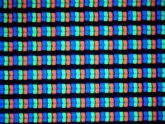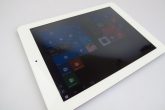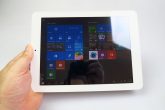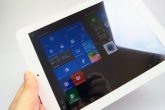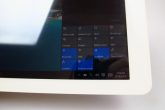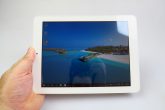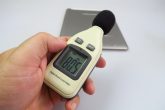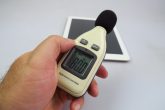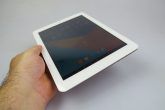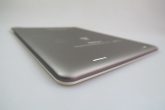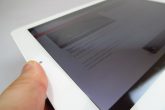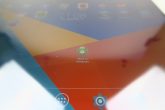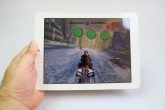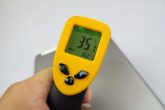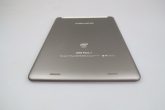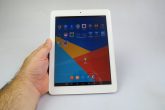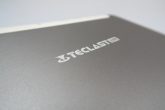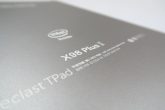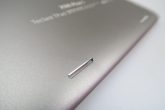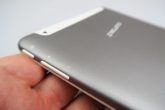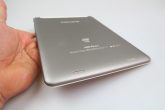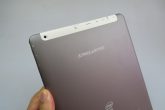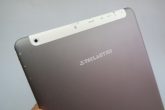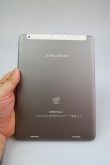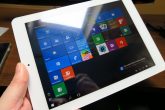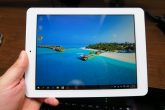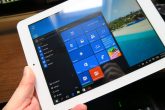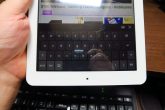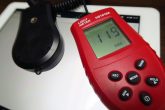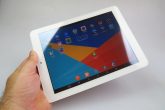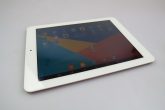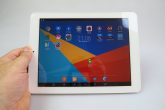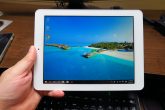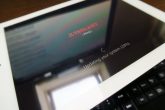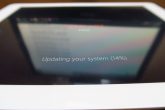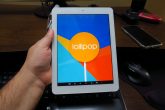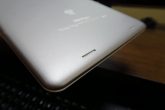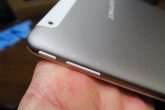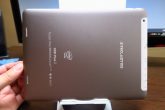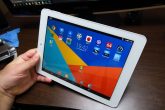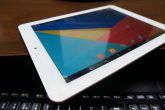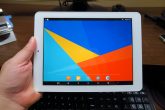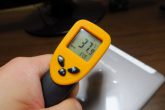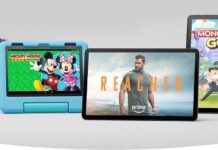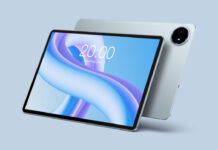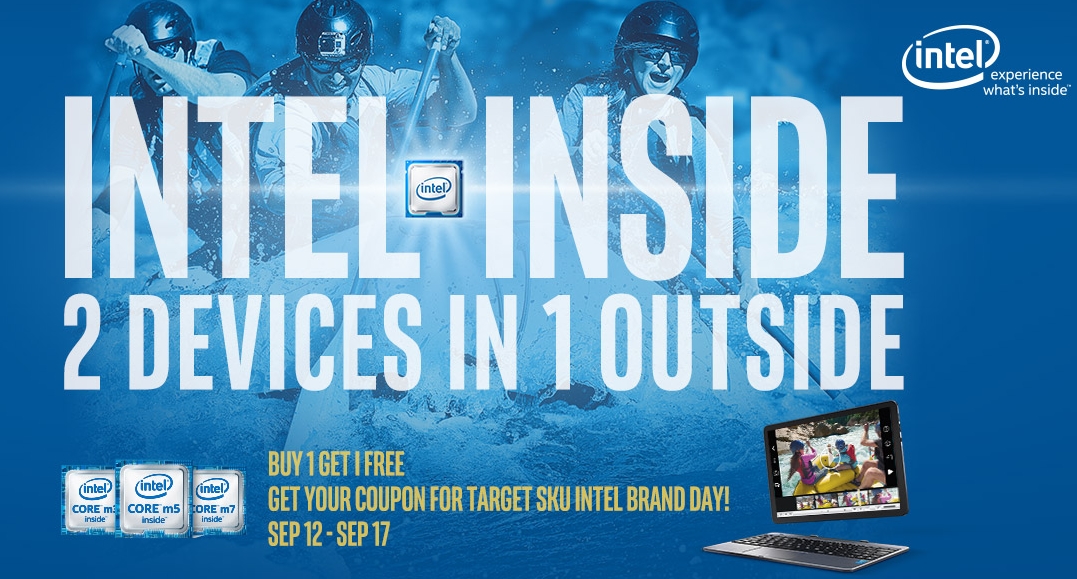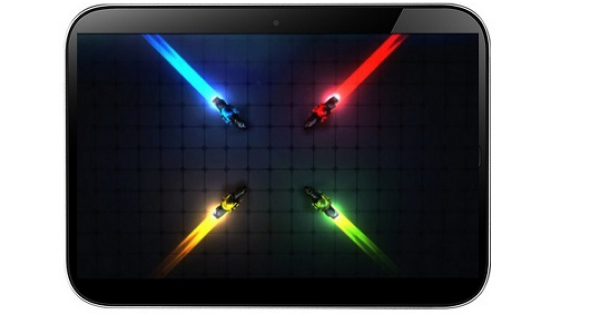It seems it’s raining dual boot tablet these days, since after testing and reviewing the Chuwi Hi12, it’s now the turn of the Teclast X98 Plus II model. It’s also a dual boot device, but this time slightly smaller, at 9.7 inches in diagonal. Priced at $164.99, the slate is an Intel Cherry Trail device, good for gaming and video watching indoors. It’s clearly affordable, but it also makes some serious compromises.
Design-wise, we get an 8 mm thick shell, a reasonable waistline for such a product, while the weight is 568 grams, a bit heavy for this type of product. To put it into perspective, it’s 100 grams grams heavier than the iPad Air 1, but it has the same diagonal. There’s a matte metal plate at the back and the device offers solid grip, comfy buttons and big bezels.
The build is quite OK, but I noticed that the front attracts quite a few scratches and prints. Teclast X98 Plus II feels rather comfy in the hands and lap and unlike the recently tested Chuwi model, it doesn’t sport any keyboard connectors. It’s got rounded corners, also slightly rounded edges and it’s solidly built for its price.
The display on board is a 9.7 incher, with an IPS LCD panel and a 10 point touch experience. The resolution is 2048 x 1536 pixels, amounting to a 264 ppi density. There’s no specialized video player on Android, so we had to resort to Gallery for that task. The viewing experience brought on OK colors, a reasonable (more or less) brightness at first sight and wide view angles.
It’s clear from the video review that the screen is very reflective and not bright. The front panel also draws grease and prints to it. Pixels have an RGB Stripes setup and the luxmeter test we did showed a very underwhelming 119 LUX result, which is the lowest we’ve ever measured and believe me, we have tested quite a few tablets. It’s even below the Chuwi Vi8 Plus and its 142 LUX.
Sadly, sometimes the touch panel won’t respond to my presses, which is something that also bothers me, aside from the low brightness. The device’s settings include options like brightness, font and Intel Smart Video, for smoother video playback. This tablet is only good for video watching in a darker room or perhaps doing some e-reading. The screen is a letdown no matter the price.
Moving on to other aspects, we get here an Intel Cherry Trail Z8300 processor, a quad core 1.44 GHz unit, with an Intel Gen Graphics solution and 4 GB of RAM bundled. There’s also 64 GB of storage here and a microSD card slot that offers up to 128 GB of extra storage. Android functions with pretty much no lag, while Windows 10 did bring a bit of lag, especially in apps.
The game we used for benchmark purposes, Riptide GP Renegade worked like a charm and didn’t suffer any stutter or frame drop. The graphics were also quite OK, as was the control. We move on to benchmarks, with the general results being superior to the ones of the Chuwi Hi12. We scored above it in Quadrant and also above the ASUS ZenPad 7, while in AnTuTu 6 we beat the Chuwi yet again and the Cure i7 Remix, too. In 3DMark Ice Storm Unlimited we surpassed the Galaxy Tab S2 9.7, as well as the iPad Air, but also scored below the Nokia N1.
In GFXBench 4, we even went above the Lenovo Yoga Tab 3 Pro in some sub tests and I have to say that for this price, performance was OK. As far as storage goes, you’ll get 11.9 GB on Android and 36 GB on Windows 10. The temperature test also wielded solid results, like 37.9 degrees Celsius after running GFXBench or 36.2 degrees after Riptide GP Renegade. Both are OK values and there’s no overheating here.
The Teclast X98 Plus II has an 8000 mAh/3.8V battery (Li-Ion), that in our HD video playback test achieved 4 hours and 47 minutes of play time, which may sound reasonable, but usually we perform such tests at 200 LUX, so it’s not that relevant or good, since the brightness is too low. At least we surpassed the Cube i7 Remix and Chuwi Vi8 Plus, although once again relevance is an issue on account of brightness.
In PCMark, the continuous usage simulation, we achieved 4 hours and 28 minutes, which is rather OK-ish, but once again not very relevant, on account of brightness. We surpassed the Evolio Go Fun 3G and Utok Hello 7Q LTE, but scored below the Nokia N1 and ASUS ZenPad S 8.0. Charging is done in 4 hours and 13 minutes, which is rather long, actually too long for how much time you get to use the slate.
Settings related to the battery include the typical Battery Saver on Android and the laptop-style options in Windows 10, related to brightness, idle time and the works. Not an impressive battery, especially since on paper we’re promised 7 hours of usage. On the audio front we’re treated to dual speakers at the back and one of them seems louder than the other. The Music app preinstalled on Android is an old school one, with a stock EQ, that offers options for genre presets, bass boost, surround sound.
There are also virtual volume buttons on the screen and the actual acoustic experience involves an OK bass, nice volume, well heard notes. There’s a bit of muffling on a flat surface, but in games and movies I was content with the speakers. In our decibelmeter test they delivered a modest value of 80 dBA at the front and 80.5 dBA at the back.
They both surpass the Chuwi Vi8 and Chuwi Vi8 Plus, but scored below the Nokia N1’s 89.8 dBa. Nothing special here and keep in mind that on Windows 10 we’re using Groove Music as the music player. On the camera front there’s a 2 MP back camera and a front 2 MP shooter. Options are very basic, like grille, timer, face detection, HD video, manual exposure and that’s about it.
Obviously, the pics are nothing to write home about, all yellow, grainy and dark. The colors are also messed up, but it’s a cheap tablet, so it was to be expected. The preinstalled web browser is a bit on the slow side on Android, while Microsoft Edge is a tad faster on Windows 10, although not as fast as I’d like it to be. The virtual keyboard in Windows 10 is also comfier than the one on Android.
By the way, the benchmark browser results on Android are pretty poor. Now on the connectivity front, we get the typical WiFi b/g/n and Bluetooth 4.0, microUSB, but also microHDMI, so you can output your Asphalt Xtreme session on the TV set. There’s also a microphone, audio jack and a special DC port for charging. All ports are one side, as it’s typical for a model of this kind.
It wouldn’t have hurt if we also got a full USB port, but I may be asking for too much, right? It also would have made the tablet thicker. The HDMI also has special features, like Modes, Display Scale and Overscan Compensation. I regret to also inform you that I registered a few WiFi connection drops, out of nowhere, so even the connectivity is slightly tainted here.
Now let’s talk about the OS and UI. It’s Android 5.1.1 stock, with lots of virtual buttons to accompany it, at the bottom of the screen. The widgets are stock and the carousel for multitasking is here too. The dropdown area is typical for Android, with notifications and Quick Settings. Switching between OSes happens with the press of a single button, that brings you to Windows 10 or Android respectively.
There aren’t any extra apps preinstalled on Android, so there’s no bloatware here. Very few extras are included, like UC Browser, Teclast Boot Manager or Teclast OTA. Windows 10 is available here in typical fashion, with a Start Menu, Cortana, Office apps and the option to install .EXE apps. Folders are also available and there’s a tablet mode if you feel nostalgia about WIndows 8.
One can use multiple desktops, Skype, Groove Music and the Windows Store, of course. Keep in mind that doing a recovery/reset of the Windows bit of the device may result in a bricking, so thread lightly. And now I guess it’s time for the verdict.
Here are the Pros:
- good price
- solid build
- comfy slate
- good performance
- dual boot device
- OK audio
- HDMI is available here
- no bloatware
And the Cons:
- very low screen brightness
- battery is underwhelming
- WiFi drops connection
- lag in Windows 10
- potential bricking in Windows 10 recovery
If I had to choose between the Chuwi Hi12 and this model, I’d go with Chuwi. There are too many compromises here, including screen brightness, battery life and some traces of lag. I’d maybe give it to a grandpa for e-reading or reading the news online, or let a little kid play casual games on it. That’s basically what it’s good for, casual games and reading, plus the occasional video, but only indoors.
If you have to do something work-related in urgent fashion, you should probably choose another device. This one is priced at $164 on GearBest.com.
[youtube -QYYgKA_hKk 660 371]
Post Footer automatically generated by Add Post Footer Plugin for wordpress.













